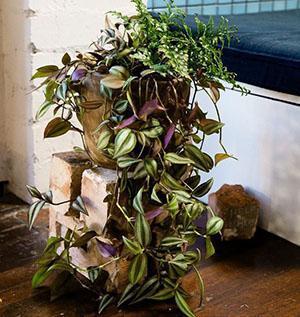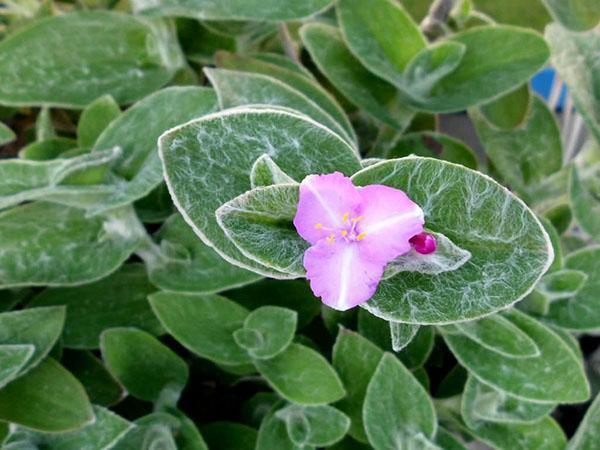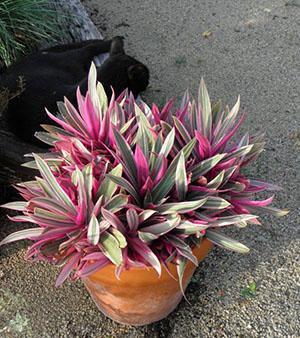Easy-care tradescantia on your windowsill
 Unpretentious fast growing tradescantia no need to introduce to indoor plant lovers. Simple home care for Tradescantia, ornamental foliage and frequent flowering are three main reasons why these herbaceous perennials have become regulars both indoors and in garden plots for many decades.
Unpretentious fast growing tradescantia no need to introduce to indoor plant lovers. Simple home care for Tradescantia, ornamental foliage and frequent flowering are three main reasons why these herbaceous perennials have become regulars both indoors and in garden plots for many decades.
Small plants with predominantly creeping stems are found naturally on the American continent, where they inhabit regions from temperate latitudes to the tropics. Tradescantia have adapted well to their habitat. In arid regions, you can see plants with dense leaves, the pile on which does not allow precious moisture to evaporate. In humid places, there are species with juicy stems and such bright glossy foliage.
The undemandingness of room tradescantia, the variety of decorative species and varieties attract the attention of both beginners and experienced florists. And more recently, garden tradescantia has appeared in Russian gardens, which does not differ from domestic relatives in either attractiveness or responsiveness to care.
Home care for tradescantia

Indoor tradescantia with smooth thin leaves love partial shade and grow best in moderately moist soil. Moreover, variegated varieties are more demanding on lighting... Under the bright sun, they turn pale, and in the shade they risk losing their pattern and becoming completely green.
 It is best for a room tradescantia, as in the photo, to find a place on the east or west window. On the south side, the plant will need shading, and on the north side, there is a danger:
It is best for a room tradescantia, as in the photo, to find a place on the east or west window. On the south side, the plant will need shading, and on the north side, there is a danger:
- excessive stretching of shoots;
- reduction of leaves;
- lack of flowering;
- rapid loss of decorativeness.
Most species are thermophilic, but in the summer months it is useful to carry Tradescantia to the balcony, garden or loggia, having previously protected the pot from the scorching sun and drafts.
 The comfortable temperature for Tradescantia is from 20 to 25 ° C in summer, and a few degrees lower in winter. Although a cool hibernation is preferable, in many cases, indoor tradescantia grows well without seasonal changes in conditions. The air becomes critically cold for plants at a temperature of 10–12 ° C.
The comfortable temperature for Tradescantia is from 20 to 25 ° C in summer, and a few degrees lower in winter. Although a cool hibernation is preferable, in many cases, indoor tradescantia grows well without seasonal changes in conditions. The air becomes critically cold for plants at a temperature of 10–12 ° C.
Many tradescantia, in addition to the indigenous inhabitants of semi-deserts, are excellent for keeping in moist soil and in the warm season they require frequent and abundant watering, irrigating foliage and taking a shower. After watering, the earth ball should be evenly moist. Since only the top layer usually dries up by the next procedure, in the summer, indoor tradescantia are watered at least every other day.

The culture is characterized by rapid growth, therefore, additional feeding must be included in the care of room tradescantia at home. They are carried out in the summer months and in the spring with an interval of 10-14 days. The plant is quite suitable for ready-made complex fertilizers for indoor crops, but variegated forms will have to take a special approach.Due to the abundance of organic matter, such indoor tradescantia is actively growing foliage, however, it can lose the decorative variegated color of greenery.
Pruning, reproduction and transplantation of room tradescantia
The rapid growth and formation of beautiful ampelous shoots is an important advantage of Tradescantia. But in order for the indoor tradescantia, as in the photo, to retain its shape and attractiveness, the stems and the central part of the plant do not look bare, the plant needs to be often pinched and updated, forcing it to bush as actively as possible.
 You can cut the growing stems throughout the warm season. The apical cuttings used for vegetative propagation of Tradescantia root perfectly in ordinary water, after which several pieces are planted in their own pots or serve to rejuvenate the mother plant. If it is decided to use the stem sections as seedlings, their length should be at least 5 cm.
You can cut the growing stems throughout the warm season. The apical cuttings used for vegetative propagation of Tradescantia root perfectly in ordinary water, after which several pieces are planted in their own pots or serve to rejuvenate the mother plant. If it is decided to use the stem sections as seedlings, their length should be at least 5 cm.
With proper home care, Tradescantia, as in the photo, recovers very quickly after pruning, and the seedlings turn into adult fluffy specimens that bloom in the second or third year.
For planting new and replanting existing tradescantia, you should not take an overly nutritious, organic-rich soil, in which the plants quickly "fatten", refuse to bloom.
 It is best for an ampelous "American" to purchase a ready-made substrate for indoor plants or mix leafy and soddy ground in equal parts, adding sand and a little peat... A powerful drainage layer is made at the bottom of the pot. A transplant of tradescantia during home care is carried out in the spring as the bush ages and the root system grows.
It is best for an ampelous "American" to purchase a ready-made substrate for indoor plants or mix leafy and soddy ground in equal parts, adding sand and a little peat... A powerful drainage layer is made at the bottom of the pot. A transplant of tradescantia during home care is carried out in the spring as the bush ages and the root system grows.
Growing and caring for garden tradescantia
In indoor conditions, ampelous species are most popular with florists. And garden tradescantia are actively flowering perennials, forming dense caps of greenery due to erect and lodging shoots with a growth of 20 to 50 cm in length.
 The most common garden tradescantia, as in the photo, are considered hybrid plants, combined into a single species "Virginia tradescantia". They:
The most common garden tradescantia, as in the photo, are considered hybrid plants, combined into a single species "Virginia tradescantia". They:
- grow rapidly in a moderately warm European summer;
- bloom profusely, giving a mass of white, purple, blue and bright blue flowers;
- stand out against the background of other plants with a variety of foliage colors from rich green and gray to purple and even yellow.
 Due to the different growing conditions, caring for a garden tradescantia differs from the care that plants receive at home.
Due to the different growing conditions, caring for a garden tradescantia differs from the care that plants receive at home.
Flowers planted on flower beds and borders cannot be moved or rearranged if their delicate leaves are in deep shade or in the July sun. Therefore, the site for the garden tradescantia is chosen very carefully.
It is optimal if the plant finds a place in partial shade, where the ground will keep moisture for a long time, but at the same time be ventilated. All Tradescantia are extremely drought tolerant. It is important to consider this not only when planting a garden tradescantia, in the photo, but also when leaving on it.
 Before planting the plant in the ground, fertilize the soil with a full dose of a complex mineral agent. Then feeding is carried out with a liquid composition every 10 days. The soil under the flowers is moistened in the morning or evening hours, when there is no threat of sunburn for the leaves of the plant.
Before planting the plant in the ground, fertilize the soil with a full dose of a complex mineral agent. Then feeding is carried out with a liquid composition every 10 days. The soil under the flowers is moistened in the morning or evening hours, when there is no threat of sunburn for the leaves of the plant.
 In the middle lane, garden tradescantia survive even harsh winters, for which they are either covered or simply cut off the entire aerial part of the plant. This is a fundamental difference in the cultivation of garden varieties compared to caring for Tradescantia at home. With the onset of spring and the awakening of dormant buds, new fresh shoots appear above the ground.
In the middle lane, garden tradescantia survive even harsh winters, for which they are either covered or simply cut off the entire aerial part of the plant. This is a fundamental difference in the cultivation of garden varieties compared to caring for Tradescantia at home. With the onset of spring and the awakening of dormant buds, new fresh shoots appear above the ground.
Spring is a very good time for breeding garden tradescantia. This is done by dividing an adult bush.Throughout the spring and the first half of summer, young plants can be obtained using cuttings. The apical parts of the shoots with 2-3 internodes are carefully cut off and rooted in the greenhouse. Roots are formed within 15–20 days, and young Tradescantia can be planted in a permanent place.